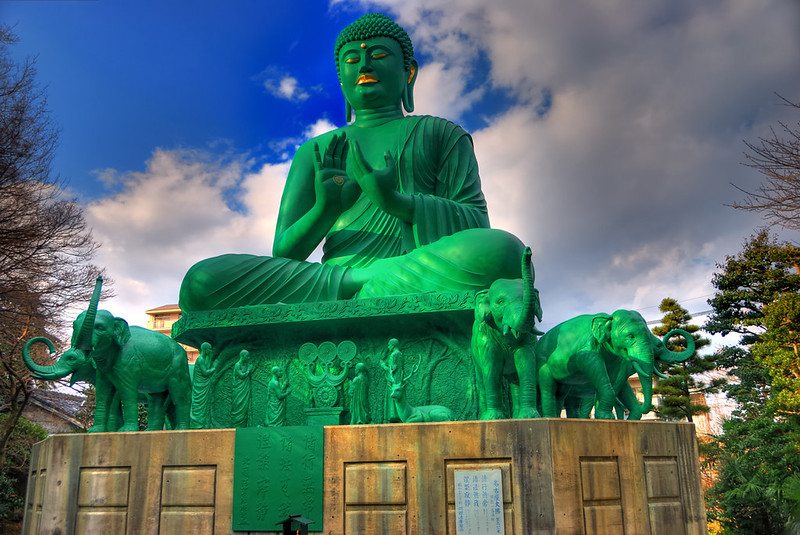Aug 31, 2022
Must-Visit, Lesser-Known Shrines and Temples of Nagoya
There are few more pleasant experiences in Japan than turning a corner of a seemingly ordinary street and suddenly finding yourself face-to-face with a beautiful old shrine or temple. This is particularly true in Nagoya, where you are regularly reminded of the ancient history of this historic land within the hustle-and-bustle of city life.
Of course, you probably already know about the most prominent landmark temples and shrines – you may have even read about them on these very pages – but as spectacular as they are, there is something special about the lesser-known places of worship. Seemingly everywhere, you can find a shrine or temple with an amazing history, and here are a few to keep an eye out for.
Ryusenji Temple
Along with Kasadera Kannon Temple, Jimokuji Kannon Temple, and Arako Kannon Temple, Ryusenji Kannon Temple is one of the four Kannons of Owari, designated by the first Tokugawa Shogun of Japan, Tokugawa Ieyasu (1543-1616), as protectors of Nagoya Castle.

Ryusenji Temple dates back to the Enryaku Period (782-806 CE), founded by the great Buddhist leader Denkyo-daishi. The temple’s Niomon gate, and a wooden statue of Jizo Bozatsu, the guardian deity of travelers and children, are designated as Important Cultural Properties. Not to be missed are the hundreds of Buddhist statues that include Batokannon, an image of Kannon with the head of a horse.
Where: 1 Chome-902 Ryusenji, Moriyama Ward, Nagoya (map)
Website: ryusenji.com
Toyokuni Shrine
If you are looking for shrines dedicated to influential Nagoyans, they don’t get much bigger than Toyokuni Shrine. Erected in 1885 in what is now known as Nakamura Park, Toyokuni Shrine is home to the spirits of one of Japan’s great unifiers, Hideyoshi Toyotomi (1536 – 1598) – who was believed to have been born on the site – and his loyal general and cousin Kato Kiyomasa (1562 – 1611).

The shrine is unmissable due to its 24-meter tall torii gate near Nakamura Koen Subway station and is believed to bring worshipers good fortune in careers and construction. In 1910 it was expanded by the addition of the Nakamura Park Memorial Museum, which was built in the traditional shoin-zukuri style, and is a rare example of an extant Meiji Period (19868 – 1912) wooden public building.
Where: Kinoshitayashiki Nakamuracho, Nakamura Ward, Nagoya (map)
Website: toyokuni-jinja.jp
Arako Kannon
Another of the Four Kannons of Owari, Arako Kannon, is the site of Nagoya’s oldest wooden structure, a two-story pagoda dating back to 1536. Believed to have been founded by the monk Taicho (682-767 CE), perhaps the sculptor Enku (1632-1696) left the greatest mark on Arako Kannon.

Enku’s work is most apparent in the pair of three-meter tall Nio guardian statues, which are, unfortunately, difficult to see behind their plastic screens. In 1972, “the thousand faces of the Bodhisattva” were discovered in the temple’s pagoda, which Enku carved from leftover chips of the Nio guardian’s carvings.
Where: Miyamado-138 Arakocho, Nakagawa Ward, Nagoya (map)
Website: city.nagoya.jp
Seimei Shrine
When Abe no Seimei (921 – 1005 CE), the legendary master of Yin and Yang, spent time in what is now known as Nagoya, it is said he cleared all venomous snakes from a local hill, and Seimei Shrine was established in his name to mark the event.

The first thing you notice about Seimei Shrine is the pentagram symbols that dot the area. To western eyes, this may take on something of an occult motif, but it symbolizes the Five Chinese Elements of wood, fire, earth, metal, and water. Either way, the appearance of the pentagram is almost unique in the area and is as striking as it is unusual.
Where: 1 Chome-6 Seimeiyama, Chikusa Ward, Nagoya (map)
Tel: 052-711-8803
Toganji Temple
You would think being built in the 16th century by Lord Oda Nobuyuki (1536-1557) in honor of his father, Oda Nobuhide (1510-1551), would be enough to give Toganji importance on its own. However, a ten-meter high Buddha on a five-meter pedestal was added in 1987, making it a temple worth visiting.

Decorated in vivid green and gold, the Buddha towers over the leafy Motoyama suburb, but it is not the sole reason to visit Toganji. With links to Indian high priests, the temple features a Shiva-Lingam and a shrine dedicated to the Goddess Saraswati, the Hindu goddess of knowledge, music, and art. The small grounds are beautifully tended.
Where: 2 Chome-16 Yotsuyatori, Chikusa Ward, Nagoya (map)
Website: city.nagoya.jp
Image: By TOSHIHARU SATO via flickr.com [CC BY 2.0]
Image: By Japanexperterna.se via flickr.com [CC BY 2.0]
Image: By HIDEO YAMADA via flickr.com [CC BY 2.0]
Image: By Gift N. T. via flickr.com [CC BY 2.0]
Image: By Yevgen Pogoryelov via flickr.com [CC BY 2.0]

About the author